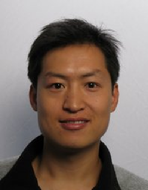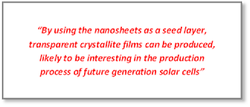 This thesis focuses on metal oxide nanosheets that show advantages in applications such as thin film growth and design of functional devices. The exfoliation on layered metal oxides and the formation of their Langmuir Blodgett (LB) films (organic monolayers) was studied. ‘We performed detailed investigations involving the whole process, leading to multiple interesting results,’ Huiyu Yuan says. ‘Our group focused on metal oxides instead of graphene produced from graphite. The acid based reactions - accompanying separator molecules which are inserted within the layers - led to very fast exfoliation process times. This procedure led to good quality nanosheets within minutes, and it is different from what was previously thought.’
This thesis focuses on metal oxide nanosheets that show advantages in applications such as thin film growth and design of functional devices. The exfoliation on layered metal oxides and the formation of their Langmuir Blodgett (LB) films (organic monolayers) was studied. ‘We performed detailed investigations involving the whole process, leading to multiple interesting results,’ Huiyu Yuan says. ‘Our group focused on metal oxides instead of graphene produced from graphite. The acid based reactions - accompanying separator molecules which are inserted within the layers - led to very fast exfoliation process times. This procedure led to good quality nanosheets within minutes, and it is different from what was previously thought.’

The work of Huiyu about the rapid exfoliation was published in Angewandte Chemie International Edition. Furthermore, as a result of his in-depth research, a step exfoliation process was established to ensure the fabrication of high-quality nanosheet films. Also a protocol to fabricate potassium calcium niobate (KCNO) crystals with different crystallite sizes, was established, in order to synthesize calcium niobate nanosheets.
‘From here LB-films were fabricated to be used as templates for piezo films,’ Huiyu says. ‘By using the nanosheets as a seed layer, transparent crystallite films can be produced as well, likely to be interesting in the production process of future generation solar cells.’
Grenoble

Huiyu especially has good memories on his visiting the European Synchrotron Radiation Facility in Grenoble. ‘During my PhD project I visited the place four times, always coming home with very good results,’ he shares. ‘The results were stunning and we really had to convince colleagues in the field of our results. The exfoliation processes we used, was not studied in depth before. The process mechanisms are quite different and the exfoliation times were very fast. I had to convince even myself, before bringing this message across.’
Parallel processes
During his PhD Hiuyu learned to manage several parallel work flow processes. ‘I discovered this is an important skill in science,’ he says. ‘In the beginning of the project I sometimes was a little bit carried away by the urge to pursuit lots of ideas simultaneously. I learned it is better to follow two or three paths before starting a new one.’
XUV post-doc

Huiyu will be working as post-doc the next year to come, at the XUV Optics Group, led by Professor Fred Bijkerk. Here he will work with a focus on optical devices.
Huiyu: ‘My knowledge on nanosheet fabrication will be of added value. Right now I feel confident to stay and work in academics, developing new science and work towards applications from there. I cherish this ratio of academic work and its meaning for novel application areas. Also, I am very happy a successor will carry further my work on the fabrication of nanosheets. The academic environment at Mesa+ I like very much, sharing knowledge and learning from one another.’
